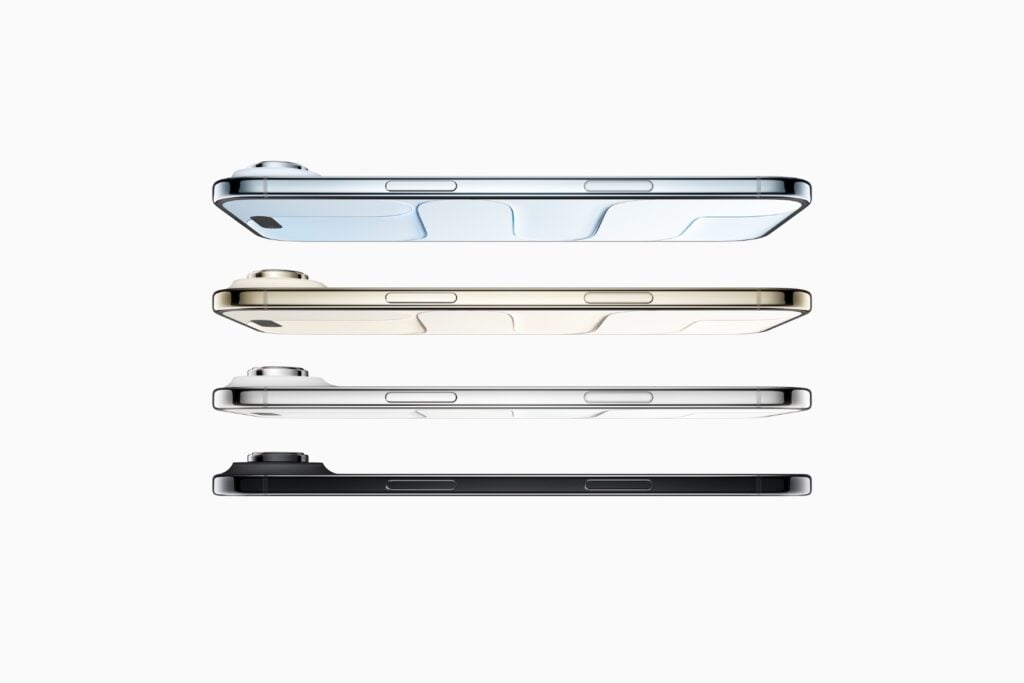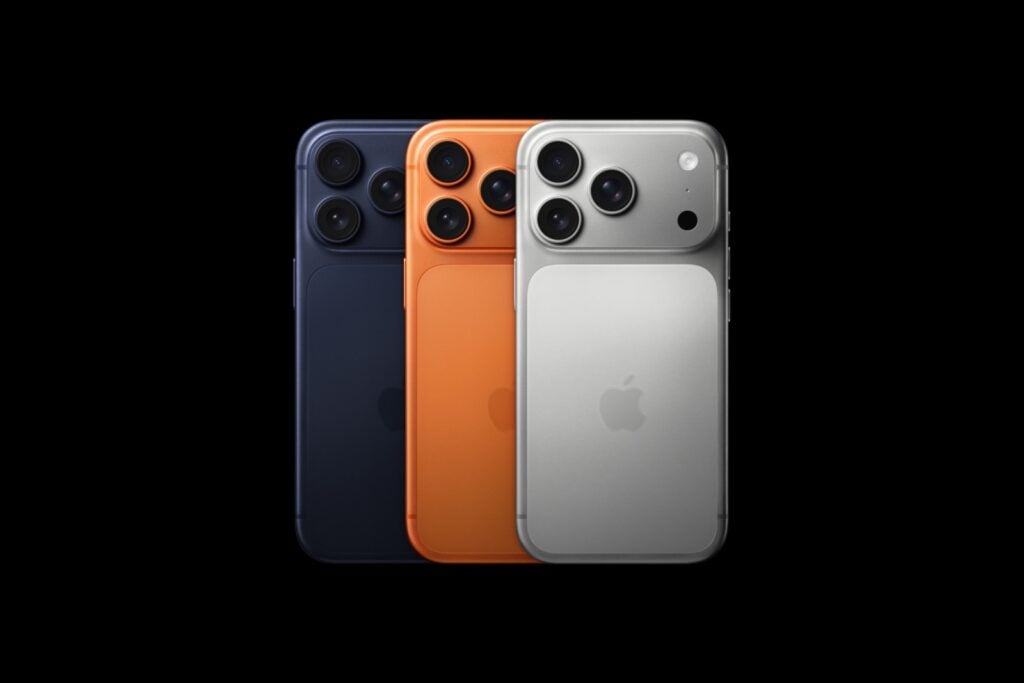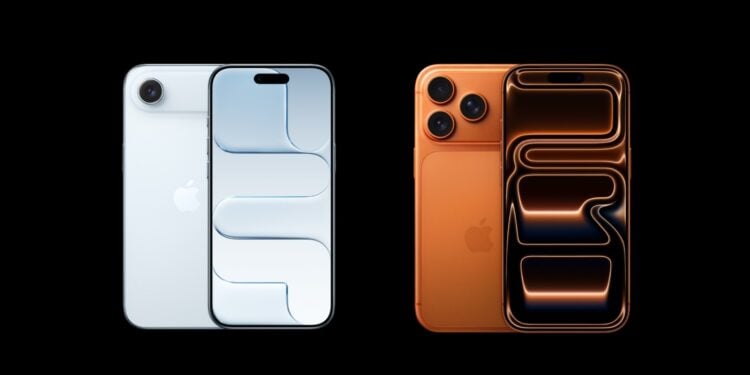The iPhone lineup for 2025 presents a difficult choice: iPhone 17 Pro or iPhone Air. Both models share many technical features, but differ in important areas. There are differences, particularly in the camera system, battery life, and interfaces, that are noticeable in everyday use.
Apple has pursued a clear strategy this year: more high-end features are being added to the broader iPhone range. At the same time, the Pro series remains at the forefront of classic professional features. Both models appear similar at first glance, but differ in design, camera, performance over extended use, and additional details like USB transfer or SIM support. Anyone considering buying an iPhone 17 should be aware of these differences.
Display: same strength, just different sizes
The iPhone Air and Pro models feature the same Super Retina XDR panel. They support ProMotion at up to 120 Hz, variable refresh rates, and an Always-On display. The option to disable PWM is also available on all devices. The only difference is their size: the iPhone Air measures 6.5 inches, the iPhone 17 Pro 6.3 inches, and the iPhone 17 Pro Max 6.9 inches.
Dimensions and weight: thin versus solid
The iPhone Air features an ultra-thin design, measuring just 5.64 mm thick and weighing 165 grams. The iPhone 17 Pro is significantly thicker at 8.75 mm and weighs 206 grams. The Pro Max weighs 233 grams. This makes the Air the thinnest and lightest device in the lineup, while the Pro series appears visibly heavier and more robust.

Battery life: longer stamina in the Pro
The difference in weight is directly reflected in the battery life. The iPhone Air offers up to 27 hours of video playback. The iPhone 17 Pro lasts up to 33 hours, and the Pro Max even up to 39 hours. This puts the Air on par with the iPhone 16 Pro, but noticeably slower than the 17 Pro series.
Camera: one module against three
The camera systems show the biggest difference. The iPhone Air has only a single rear camera, while the iPhone 17 Pro offers a triple system. Both have a 48 MP Fusion main camera, but the Air lacks a telephoto and ultra-wide-angle lens, as well as important additional features. The Air offers no macro shots, 3D photos, or videos. ProRAW and Cinematic mode are also not available. The four-microphone array, the LiDAR scanner, and professional features like Genlock and Apple Log 2 are also missing.
- In detail, it looks like this: The Air offers optical zoom up to 2x, the Pro up to 8x. 4K Dolby Vision runs up to 60 fps on the Air, and up to 120 fps on the Pro. Slow-motion videos are available on the Air in 1080p, while the Pro can record in 4K. The flash on the Air is True Tone, while the Pro has adaptive True Tone. In terms of image stabilization, the Air relies on sensor-shift OIS, while the Pro uses the improved second generation.
At least: The Center Stage front camera is installed in all new iPhones.

Performance: same base, but more stable in the Pro
At the core of both models is the A19 Pro chip, each with 12 GB of RAM. The difference lies in the details: The Air has a 5-core GPU, while the Pro models have a 6-core GPU. Furthermore, only the Pro models have a vapor chamber for cooling. This ensures better continuous performance, for example, in games or video editing.
Design and colors: aluminum or titanium
There are also clear differences in the materials. The iPhone 17 Pro features a new unibody design made of aluminum, which initially elicits mixed feelings. It's available in Cosmic Orange, Deep Blue, and Silver. The iPhone Air, on the other hand, uses titanium, giving it a particularly slim and elegant appearance. It's available in Sky Blue, Light Gold, Cloud White, and Space Black.
Prices and storage: Starting from 1,199 euros
The iPhone Air starts at €1,199 with 256 GB of storage. The iPhone 17 Pro costs €1,299, and the Pro Max €1,449. Storage upgrades cost €250 per tier for all models. The Air and Pro offer up to 1 TB, while the Pro Max offers up to 2 TB exclusively.
Connectivity and ports: Differences in detail
The interfaces are also split. The iPhone Air uses the Apple C1X 5G modem, while the Pro models continue to rely on Qualcomm with mmWave support (only in the US). In terms of SIM support, the Air remains limited to eSIM, while the Pro models also allow a physical SIM. When it comes to USB connectivity, the Pro is clearly ahead. The Air only supports USB 2 over USB-C, while the Pro supports USB 3 with up to 20 times faster transfer rates.
- iPhone Air vs. iPhone 17 Pro: Which is the better choice?
- iPhone 17: Apple introduces groundbreaking security feature
- iPhone 17 Pro uses aluminum – all the reasons in detail
iPhone 17 Pro or iPhone Air: Which is better?
The iPhone 17 Pro and iPhone Air serve different needs. Those who value maximum camera flexibility, long battery life, fast data transfer, and professional features will find the iPhone 17 Pro a more suitable choice. On the other hand, those who prefer an extremely light, thin device with a top-notch display and a powerful chip will find the iPhone Air a perfect fit – but will consciously forgo camera extras, longer battery life, and some interfaces. This means the decision comes down to priorities: a lightweight, everyday device or a fully equipped Pro model. The best products for you: Our Amazon Storefront offers a wide selection of accessories, including accessories for HomeKit. (Image: Apple)
- iPhone 17 vs. iPhone 16: All the differences in detail
- iPhone 17 Pro vs. iPhone 17 Pro Max: Differences at a glance
- iPhone Air: Seven facts about the new ultra-thin smartphone
- AirPods Pro 3: Apple's headphones with 8 exciting upgrades
- AirPods Pro 3 vs. AirPods Pro 2: The big comparison in detail
- Is the iPhone 17 Pro not worth it? The iPhone 18 Pro in focus
- Apple Watch Ultra 3 vs. Ultra 2, Series 11: Battery comparison
- iPhone 17 Pro: Everything about the new camera platform & more
FAQ about the iPhone 17 Pro and iPhone Air
The biggest differences are in the camera, battery life, weight, and ports. The iPhone 17 Pro offers a triple camera system, longer battery life, and a faster USB 3 port, while the iPhone Air is ultra-thin and lighter.
The iPhone 17 Pro features a triple camera system with telephoto and ultra-wide lenses, 8x zoom, and pro video capabilities. The iPhone Air has only a single main camera and lacks many pro features.
Both models feature an identical Super Retina XDR display with ProMotion and Always-On. The only difference is the size: 6.3 inches for the iPhone 17 Pro and 6.5 inches for the iPhone Air.
The iPhone 17 Pro lasts longer, with up to 33 hours of video playback than the iPhone Air's 27 hours. The iPhone 17 Pro Max even reaches up to 39 hours.
Yes, the iPhone Air is significantly lighter at just 165g and much thinner at 5.64mm. The iPhone 17 Pro weighs 206g and is more robustly built.
Both models use the A19 Pro chip with 12 GB of RAM. There are differences in the GPU and cooling: The iPhone 17 Pro offers a 6-core GPU and a vapor chamber for better continuous performance.
The iPhone 17 Pro is available in Cosmic Orange, Deep Blue, and Silver. The iPhone Air comes in Sky Blue, Light Gold, Cloud White, and Space Black.
Only the iPhone 17 Pro continues to support physical SIM cards. The iPhone Air relies exclusively on eSIM.
The iPhone Air only supports USB 2 over USB-C. The iPhone 17 Pro offers USB 3, which enables data transfers up to 20 times faster.
The iPhone Air starts at €1,199, and the iPhone 17 Pro at €1,299. Storage upgrades cost €250 extra for both devices.





